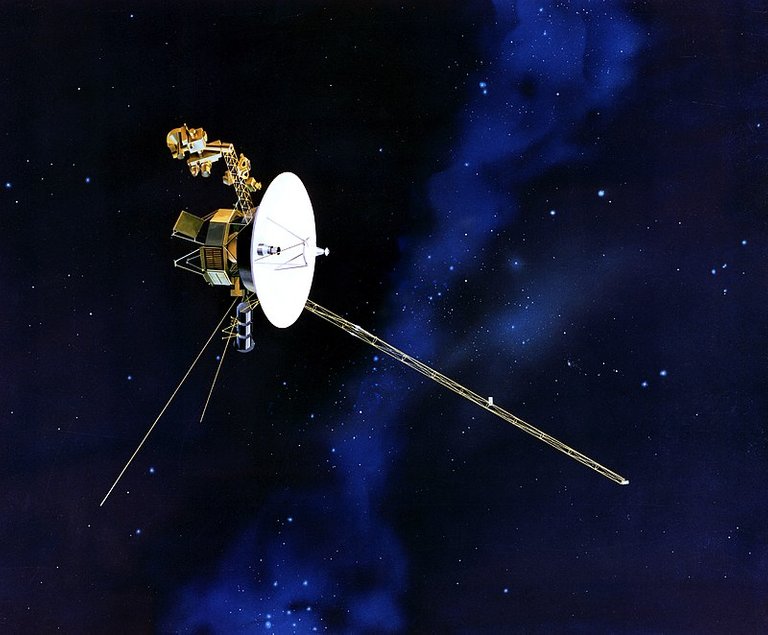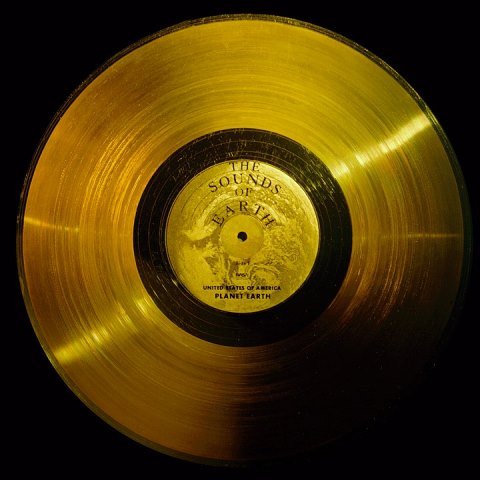Where are the Voyagers?
The Voyager 1 and Voyager 2 probes do not stop making history, more than 40 years have passed since their launch and they are still exploring space in the far reaches of the solar system.

Representation of one of the Voyager probes in space. Source: wikipedia.com.
Among the multitude of vehicles and satellites that have been launched into space, these probes are the first man-made objects to enter interstellar space and continue sending data.
The Voyager probes were launched by NASA in 1977 to study the outer planets of our solar system, the Voyager 1 probe passed by Jupiter in 1979 and Saturn in 1980, while its sister spacecraft managed to reach Uranus in 1986 and Neptune in 1989.
In addition to carrying the scientific equipment necessary to carry out various studies, both spacecraft carry a gold disc with a selection of music from various countries and cultures, a greeting in 55 languages and images including the location of the solar system.

Voyager gold disc titled "The sounds of the earth". Source: wikipedia.com.
After completing their mission to the outer planets, the Voyager spacecraft continued their journey studying the environment of the outer solar system, thanks to the fact that they are equipped with nuclear electric generators that have allowed their instruments to continue functioning and sending signals to Earth.

Trajectory recorded for Voyager 1. Source: Wikipedia.com.
In 2013 NASA scientists reported that Voyager 1 would have become the first man-made object to reach interstellar space, after much debate about whether or not it would have left the so-called heliosphere, after verifying new data confirmed that the spacecraft had left the bubble of hot particles surrounding the solar system and entered the cold and dark environment of interstellar space. On the other hand, scientists confirmed that Voyager 2 had left the influence of the sun in 2018, but still did not leave the solar system, as it is still within the Oort cloud, a cloud of trans-Neptunian objects at the edge of the solar system.
The key to detecting that the two spacecraft jumped into interstellar space was precisely the jump in plasma density detected by their instruments. While they remained in the heliosphere region, they recorded a hot and less dense plasma, influenced by the solar wind, and then began to record the transition to a region of colder and denser plasma, characteristic of interstellar space.

Representation of the Heliosphere and location of the Voyager spacecraft.. Source: Wikipedia.com.
The data collected suggest that the heliosphere is symmetrical in shape, as the points where the probes crossed into interstellar space are at a very similar distance from the sun, suggesting a spherical front in this bubble. Voyager 1's entry into interstellar space occurred at 122.6 Astronomical Units, or AU, while Voyager 2 did the same at 119.7 AU.
Through NASA's Eyes application we can follow the trajectory of both probes, at the time of this publication, Voyager 1 was 23.3 billion kilometers from Earth traveling at 61026 km/h, while Voyager 2 was 19.45 billion km from Earth, traveling at 55112 km/h.
These mythical spacecraft are a milestone of humanity and space exploration, for four decades they have helped us to understand the solar system and more recently interstellar space, and will continue their task of exploration while traveling to the Oort cloud, and when they pass through it, they will continue their journey through the galaxy, although by then their nuclear battery will have been exhausted and the dust and solar radiation will have wreaked havoc on the spacecraft.
Thanks for coming by to read friends, I hope you liked the information. See you next time.
@tipu curate
Upvoted 👌 (Mana: 0/83) Liquid rewards.
Thanks for the support!
Hello @emiliomoron
Good data that you share with the community, certainly few times we stop to know this kind of information "the heliosphere has a symmetrical shape", it's great to know what we can achieve with this kind of projects.
Best regards, be well.
Hi my friend, no doubt these probes have provided important knowledge. Greetings!
Oh, I've listened to the collection of music on that gold disc. I love it, although it also makes me a little melancholy about those probes. Unfortunately, we'll stop hearing from them very soon. That'll be sad.
That's right my friend, it will be sad when we can no longer have news of such iconic space probes.
Some years ago I read a great article about the engineers working in Mission Control for the voyagers:
https://www.nytimes.com/2017/08/03/magazine/the-loyal-engineers-steering-nasas-voyager-probes-across-the-universe.html
Not only the spacecraft are ageing, team is doing it with it. And this experienced team is the only people in NASA with some skills for some technologies that are already extremely out of fashion.
And this skills will become even more critical when the mission comes towards am end and system stars not to work so well.
And the mission will struggle not only because the spacecraft are running out of fuel (radioactive plutonium), but because the members of the team will retire!
Certainly solving the problems that may appear in the systems of these spacecraft requires highly qualified scientists in those early space exploration systems, I also read that the current equipment is already very small, it will certainly be difficult to keep them operational in the future.
I had forgotten about where those probes were precisely for some time. It is then always cool to have those being remembered, as we will probably lose them for good soon (as @eniolw said it). If I am correct, I however think we still have like 10 years in front of us. (I cannot check this last statement right now.)
Thanks for the post! Cheers!
Yeah, I will join NASA and world scientists from the distance in their grief when that happens.
You will join NASA as a NASA employee hopefully ^^
That's right my friend @lemouth, it's always good to remember these historic probes, certainly soon we could lose sight of them forever, hopefully we can keep track of them for a little while longer.
And I think many of us will @eniolw.
Thanks for your contribution to the STEMsocial community. Feel free to join us on discord to get to know the rest of us!
Please consider delegating to the @stemsocial account (85% of the curation rewards are returned).
You may also include @stemsocial as a beneficiary of the rewards of this post to get a stronger support.
Thanks for the support friends!
Maybe they will find them later and send them to the museum.